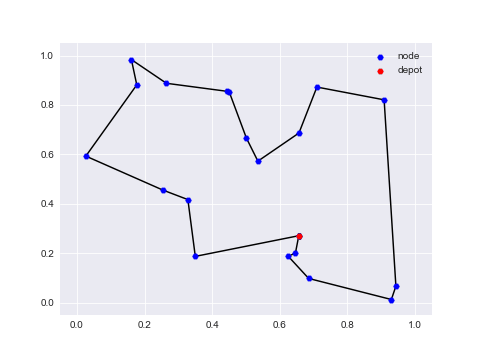A fork of yining043/VRP-DACT
DACT is a learning based improvement model for solving routing problems (e.g., TSP and CVRP), which explores dual-aspect representation, dual-aspect collaborative attention (DAC-Att) and cyclic positional encoding (CPE). It is trained by n-step Proximal Policy Optimization (PPO) with a curriculum learning (CL) strategy.
This repo implements our paper: Yining Ma, Jingwen Li, Zhiguang Cao, Wen Song, Le Zhang, Zhenghua Chen, Jing Tang, “Learning to iteratively solve routing problems with dual-aspect collaborative transformer,” in Advances in Neural Information Processing Systems, vol. 34, 2021. Please cite our paper if the code is useful for your project.
@inproceedings{ma2021learning,
author = {Ma, Yining and Li, Jingwen and Cao, Zhiguang and Song, Wen and Zhang, Le and Chen, Zhenghua and Tang, Jing},
booktitle = {Advances in Neural Information Processing Systems},
editor = {M. Ranzato and A. Beygelzimer and Y. Dauphin and P.S. Liang and J. Wortman Vaughan},
pages = {11096--11107},
publisher = {Curran Associates, Inc.},
title = {Learning to Iteratively Solve Routing Problems with Dual-Aspect Collaborative Transformer},
url = {https://proceedings.neurips.cc/paper/2021/file/5c53292c032b6cb8510041c54274e65f-Paper.pdf},
volume = {34},
year = {2021}
}
You may also be interested in our new approach called N2S (IJCAI 2022) which makes DACT more efficient for solving pickup and delivery problems (PDPs).
Paper: Yining Ma, Jingwen Li, Zhiguang Cao, Wen Song, Hongliang Guo, Yuejiao Gong and Yeow Meng Chee, “Efficient Neural Neighborhood Search for Pickup and Delivery Problems,” in the 31st International Joint Conference on Artificial Intelligence and the 25th European Conference on Artificial Intelligence (IJCAI-ECAI 22), 2022.
- Python>=3.6
- PyTorch>=1.1
- numpy
- tensorboard_logger
- tqdm
- cv2
- matplotlib
For the exception below from package tensorboard_logger,
AttributeError: module 'scipy.misc' has no attribute 'toimage'Please refer to issue #27 to fix it.
Training data is generated on the fly. Please follow repo wouterkool/attention-learn-to-route to generate validating or test data if needed. We also provide some randomly generated data in the datasets folder.
For training TSP instances with 50 nodes and GPU cards {0,1}:
CUDA_VISIBLE_DEVICES=0,1 python run.py --problem tsp --graph_size 50 --step_method 2_opt --n_step 4 --T_train 200 --Xi_CL 2 --max_grad_norm 0.2 --val_m 1 --val_dataset './datasets/tsp_50_10000.pkl' --run_name 'example_training_TSP50'For training CVRP instances with 20 nodes and GPU cards {0,1}:
CUDA_VISIBLE_DEVICES=0,1 python run.py --problem vrp --graph_size 20 --dummy_rate 0.5 --step_method 2_opt --n_step 10 --T_train 500 --Xi_CL 1 --max_grad_norm 0.04 --val_m 1 --val_dataset './datasets/cvrp_20_10000.pkl' --run_name 'example_training_CVRP20'You can initialize a run using a pretrained model by adding the --load_path option:
--load_path '{add model to load here}'You can resume a training by adding the --resume option:
--resume '{add last saved checkpoint(model) to resume here}'The Tensorboard logs will be saved to folder "logs" and the trained model (checkpoint) will be saved to folder "outputs". Pretrained models are provided in the pretrained folders.
Load the model and specify the iteration T for inference (using --val_m for data augments):
--eval_only
--load_path '{add model to load here}'
--T_max 10000
--val_size 10000
--val_dataset '{add dataset here}'
--val_m 8For inference 10,000 TSP instances with 100 nodes and no data augment:
CUDA_VISIBLE_DEVICES=0,1,2,3 python run.py --problem tsp --graph_size 100 --step_method 2_opt --eval_only --load_path 'pretrained/tsp100-epoch-195.pt' --T_max 10000 --val_size 10000 --val_dataset './datasets/tsp_100_10000.pkl' --val_m 1 --no_saving --no_tbFor inference 512 CVRP instances with 100 nodes and 8 data augments:
CUDA_VISIBLE_DEVICES=0,1,2,3 python run.py --problem vrp --graph_size 100 --dummy_rate 0.2 --step_method 2_opt --eval_only --load_path 'pretrained/cvrp100-epoch-193.pt' --T_max 10000 --val_size 512 --val_dataset './datasets/cvrp_100_10000.pkl' --val_m 8 --no_saving --no_tbSee options.py for detailed help on the meaning of each argument.
Please note that in our implementation, the VRP solution is stored in a linked list format. Let us consider a TSP-20 solution [ 6 -> 17 -> 3 -> 9 -> 16 -> 4 -> 12 -> 0 -> 1 -> 5 -> 13 -> 19 -> 11 -> 18 -> 8 -> 14 -> 15 -> 7 -> 2 -> 10 -> 6], we would store this solution as rec = torch.tensor([[ 1, 5, 10, 9, 12, 13, 17, 2, 14, 16, 6, 18, 0, 19, 15, 7, 4, 3,8, 11]]),. Here, if rec[i] = j, it means the node i is connected to node j, i.e., edge i-j is in the solution. For example, edge 0-1, edge 1-5, edge 2-10 are in the solution, so we have rec[0]=1, rec[1]=5 and rec[2]=10.
The code and the framework are based on the repos wouterkool/attention-learn-to-route and yining043/TSP-improve.

